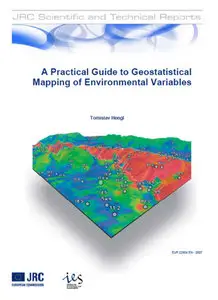"A Practical Guide to Geostatistical Mapping of Environmental Variables" by Tomislav Hengl
Institute for Environment and Sustainability: JRC Scientific and Technical Reports
EC | 2007 | ISBN: 9279069047 9789279069048 | 165 pages | PDF | 9 MB
Institute for Environment and Sustainability: JRC Scientific and Technical Reports
EC | 2007 | ISBN: 9279069047 9789279069048 | 165 pages | PDF | 9 MB
The main purpose of this guide is to assist you in using geostatistical tools with your own data. The book assists you in obtaining the software and making the first steps, warn what might be the bottlenecks and what you should avoid doing, and provide the most crucial tricks’n’tips on how to build scripts and organize the data processing.
The guide consists of four chapters.
The first chapter is an introductory chapter to the practice of geostatistical mapping and gives an overview of the spatial prediction techniques.
The second chapter zooms into regression-kriging and its characteristics, advantages and limitations.
The third chapter is completely dedicated to installation and doing first steps in the software, and the last, fourth, chapter gives a step-by-step guide through analysis and generation of final layouts by using a digital soil mapping case study.
After reading the first chapter, you should understand what the geostatistical mapping is; after reading the second chapter, you should know how to select the right spatial prediction technique for your application; after reading the third chapter, you should be able to install all packages used in the handbook and be aware of their capabilities; and after reading the fourth chapter, you should know how to run geostatistical mapping, prepare final layouts and interpret the results of analysis for your own case study.
Contents
Foreword
Disclaimer
Frequently Asked Questions
1 Theoretical backgrounds
1.1 Basic concepts
1.2 Mechanical spatial prediction models
1.3 Statistical spatial prediction models
2 Regress ion-kriging
2,1 The Best Linear Unbiased Predictor of spatial data
2.2 Local versus localized models
2.3 Spatial prediction of categorical variables
2.4 Geostatistical simulations
2.5 Spatio-temporal regress ion-kriging
2.6 Sampling strategies and optimisation algorithms
2.7 Fields of application
2.8 Final notes about regress ion-kriging
3 Hands-on software
3.1 Overview and installation of software
3.2 Geostatistics in ILWIS
3.3 Geostatistics in SAGA GIS
3.4 Geostatistics with gstat
3.5 Visualisation of maps in Google Earth
3.6 Other software options
3.7 Summary points
4 A geostatistical mapping exercise
4.1 Case study: Ebergotzen
4.2 Data import and preparation of maps
4.3 Regression modelling
4.4 Variogram modelling
4.5 Predictions and simulations
4.6 Assessing the quality of predictions
4.7 Comparison of predictions using various inputs
4.8 Visualization of the outputs
1st true PDF with TOC BookMarkLinks



